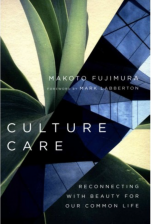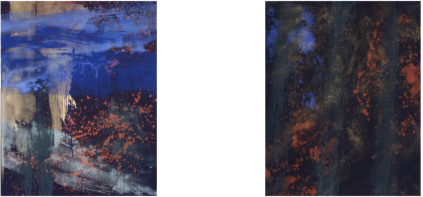Culture Care

In 2009 Japanese-American artist Makoto Fujimura was commissioned by Crossway to create an illuminated manuscript, The Four Holy Gospels, in commemoration of the 400th anniversary of the King James Bible. It was published in 2011 as part of the English Standard Version. The abstract pieces are exquisite.

Left: Charis-Kairos (Tears of Christ)*
Right: John In the Beginning**
Fujimura’s style is borrowed directly from his native Japan. Nihonga, quite literally Japanese painting, grew out of the Meiji period, and is noted by the distinct materials: wide brushes, silk, wood and paper, as well as ink, mineral pigments and metallic shavings like gold and silver. It is an art form which places high value on beauty. Mr. Fujimura is the founder of the Fujimura Institute and the International Arts Movement, which creates “a new paradigm by lovingly tending to cultural soil and caring for artists as pollinators of the good, true and beautiful.”
In his book Culture Care: Reconnecting with Beauty for our Common Life, the artist challenges modern day Christians to engage with the world around them. He encourages us to produce high quality fiction, film, paintings, sculpture, poetry, etc. in order to grow a Creator-honoring culture. Because we bear the Creator’s image, we are also intended to create. Instead of hiding from a culture that does not resonate with us, Fujimura suggests we become proactive.
“Christian communities are thus often busy with programs but rarely seen as a creative force to be reckoned with, let alone as a power of good that affects whole cities and gives everyone a song to sing.” (Culture Care, p. 96)
In recent months I have been reading and reflecting a great deal on culture and the proper response to it as a Christian. My natural instinct, honestly, is to shrink back from the excessive amounts of pop culture and politically correct trends. However, Culture Care, has urged me to think more generously about our responsibilities and opportunities to engage and inspire the people around us.
“Culture is not a territory to be won or lost,” says Fujimura, “but a resource we are called to steward with care. Culture is a garden to be cultivated.” (p. 40) Rather than retreating from a dearth of spirituality in our culture, why not create what we believe in? I am increasingly hopeful that we are capable of creating the truth, goodness and beauty in Christ’s name that we all so desperately crave.
“We create great art by loving culture…We create great art by having faith to love our neighbors as ourselves and even our enemies.” (p. 129)
How do we go about successfully creating thriving and flourishing communities? Fujimura provides us with the three Gs.
Genesis moments - What if we view the common, every day things as opportunities to create and start something new?
Generosity - What if we transformed the artist from someone interested exclusively in self expression into someone who was deeply vested in improving the lives and souls of others?
Generational - What if we were truly people who lived by faith and vision? What if we believed that our creative acts would be used by God’s Spirit for future generations, even if we couldn’t see it now?
Our stated mission at North Central is to “glorify God by fostering transformed lives into the image of Christ by the power of the Holy Spirit for the sake of the world.” As Christians focused on living out the gospel message can we be brave enough and faithful enough to speak the complete truth to our neighbors? There is more to truth and reality than the ugly aspects. “In the face of the undeniable and often unbearable human suffering all around us, we must still affirm beauty and work to make our culture reflect it. This is why a culture care approach will encourage truth telling about alienation, suffering and oppression alongside truth telling about justice, hope and restoration.” (p. 56) If we only speak to one side, it is no longer truth.
Included in Fujimura’s book is a discussion guide to help us reflect more carefully, and in community, on ways to create the beautiful culture we want. For those of us at North Central, we can ask who are the culture builders among us? Do we have writers? artists? painters? Have we been blessed with film makers? actors? musicians? architects? What about gardeners? chefs? bakers? tailors? quilters or knitters? I can think of several. If you are in a different community, I have faith God has blessed you in this way as well. How might we translate these talents into something which benefits our community? Ultimately, we do not create for ourselves, but in order to spread the knowledge of his goodness. That is, we create “for the sake of the world.”
As Makoto Fujimura so eloquently states,
“I am not a Christian artist. I am a Christian, yes, and an artist, I dare not treat the powerful presence of Christ in my life as an adjective. I want Christ to be my whole being…It is time for followers of Christ to let Christ be the noun in our lives…It is time to follow the Spirit into the margins and outside the doors of the church.” (p. 84-85)
*
• Mineral Pigments, Gold on Belgium Linen.
• 80 H x 64 W x 2.5 in”
**
• Painting: Nihonga, Platinum and Sumi on Paper.
• 60 H x 48 W x 3
